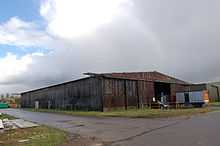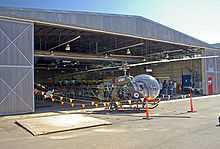Bellman hangar
The Bellman Hangar was designed in the United Kingdom in 1936 by the Directorate of Works structural engineer, N. S. Bellman, as a temporary hangar capable of being erected or dismantled by unskilled labour with simple equipment and to be easily transportable. Commercial manufacturing rights were acquired by Head Wrightson & Co of Teesdale Iron Works, Thornaby-on-Tees. By November 1938, 10 had even been supplied to Russia.
Origins of Transportable Hangars

During World War I and for some time after, the only successful transportable hangar design was the Bessonneau hangar. This could be very quickly erected and secured to provide adequate shelter for a few small aeroplanes. But with post-war increases in the number and size of aeroplanes, the need for larger transportable accommodation soon became apparent. The Air Ministry therefore issued a specification in 1936 covering the dimensions and requirements for a light transportable shed for use in war. It had to be end-opening with doors at both ends, be capable of mass production and have interchangeable parts to permit rapid erection and dismantling with minimal permanent foundations. This specification was submitted to various designers and eventually two different designs were presented - the Bellman and the Callender Hangar.
An example of each was erected at two demonstration sites (airfields) in the north-east: at RAF Thornaby an Air Ministry design was built (later to be known as the Bellman hangar) and at RAF Usworth a Callender Cable & Construction design was built (later to be known as the Callender-Hamilton hangar). Eventually, in 1938, the Bellman design was chosen as the standard Air Ministry wartime transportable shed, but Callender-Hamilton hangars were also purchased in small numbers for Royal Naval Air Stations until superseded by a new hangar type in 1943.
Construction
The Bellman hangar was designed in 1936 by N S Bellman (an Air Ministry Directorate of Works structural engineer) and its general dimensions were 175 ft long, 95 ft wide (87 ft 9in clear width) and 25 ft (clear height). It was constructed in 14 bays at 12 ft 6in centres based on a unit system of rolled steel sections; both walls and roof used the same standard units joined at the junction of wall and roof by a standard corner unit.
The time taken for 12 men to erect the hangar at Thornaby, including levelling the ground, laying door tracks, erecting the steelwork, and fitting oiled canvas doors, was 500 man-hours. Two light jib derricks using timber poles were required to erect the fabricated vertical and side members. The roof trusses were assembled on the ground before being lifted into position.
As a result of the bad winter of 1937 when a number of Bellman hangars at Thornaby were damaged after a heavy to severe fall of snow, production Bellmans were modified slightly to have steel-framed and steel-clad doors.
During the period 1938-40 some 400 Bellman hangars were built in the UK, some 230 others were manufactured in Australia and probably more were produced under licence in other Commonwealth countries too. Pre-war examples are known to have been built at Brooklands (two for Hawker Aircraft Ltd were supplied by January 1939) and at Croydon Airport (one was provided there for Air Ministry use).
Bellmans proved to be invaluable in the early part of the war and met an increasing demand not only to supplement permanent hangars, but also to provide the total hangar requirements for many temporary Armament Training, Elementary Flying Training, and Air Navigation Schools.
Hangars were purchased in bulk and in 1938 a central parts, storage depot was established at No. 3 MU at Milton, Oxfordshire. The parts for 40 Bellmans were stored in two specially built Bellman sheds for issue in the event of war. When all the hangars had been dispatched, these sheds were used for storing spare parts.
Surviving examples in the UK
Today, there are believed to be about 100 Bellman hangars still in RAF/MoD service in the UK - including Chivenor, Cosford and St Athan airfields.
Two examples are currently preserved in UK aircraft museums - one at AeroVenture near Doncaster, South Yorkshire and another at Brooklands Museum in Surrey. The latter has a clear height of 25 ft (required for dispersed production of Vickers Wellington and Warwick aircraft in WW2), became a designated Grade II Listed building in 1999, was one of ten erected at Brooklands between 1938 and 1944 and is the UK's only Listed example.
Others survive at UK civil airfields such as Booker (4), Detling (1), Fairwood Common (Swansea Airport) (1), Halfpenny Green, Stoke Orchard (1) and White Waltham (2). Further survivors can be found away from airfields in a variety of alternative uses.
The paintshop area of Southampton's recently closed Ford Transit factory started in what was referred to as the Bellman and the site was formerly part of the Cunliffe-Owen aircraft factory on the edge of Eastleigh airport (now Southampton International Airport). Very little of that original hangar structure now remains but a much larger pre-war hangar between the Bellman and the M27 motorway is still clearly visible today.
Two Bellman hangars still stand at Daedalus Airfield, Lee-on-the-Solent. Both are in use; one storing gliders for Portsmouth Naval Gliding Club, while the other is used by Britten-Norman for client aircraft maintenance.[1]
Bellman Hangars in Australia



Bellmans were also produced in Australia from c.1939–1945. They are often stated to have been made by Lysaght, but a recent history on Comeng (Commonwealth Engineering) reports that Waddington Engineering made over 200 Bellmans of a total of 283 ordered by the Air Ministry in Australia, however the steel within the structures are clearly marked as Lysaght suggesting the materials were sourced by Waddington from Lysaght, possibly explaining the conflicting stories. They were designed as easily transportable, temporary hangars which could be erected using unskilled labour. They were used on war-time airfields constructed across Australia, particularly training airfields.
Post war many were removed from the temporary wartime airfields as they closed or downsized for civilian use, and were relocated to expand or consolidate the permanent RAAF bases, or establish new civilian airfields.
In Victoria the following examples survive:
- Four imported UK constructed examples exist on the Southern Tarmac at Point Cook (RAAF Williams)
These are believed to be the only UK examples surviving in Australia.
- A further ten Australian built examples exist on the Northern Tarmac at Point Cook housing the RAAF Museum (RAAF Williams)
(These Bellmans at Point Cook are therefore on the National Heritage List).
- Five exist at the RAAF Laverton base, these are listed on the Commonwealth Heritage List of that base (RAAF Williams)
- A further two exist adjacent to RAAF Laverton base on the road next to the railway, on land excised from the site.
- Thirteen exist at (Moorabbin Airport), having been moved from elsewhere when that civilian airfield was created post war.
- Twelve exist at (RAAF Base East Sale). Now the Central Flying School but was the former No.1 Operational Training Unit under EATS.
- Five exist at (Ballarat Airport), the former No. 1 Wireless Air Gunnery School under EATS,
(These Bellmans are listed on the Victorian Heritage Register).
- Three were at Fishermen's Bend (Victoria) at the site of the Commonwealth Aircraft Corporation factory.
(These have since been relocated to Tyabb Airport.)
- Two Bellmans exist at (Essendon Airport), possibly relating to either DAP aircraft manufacturing or the EFTS operating on the site during WW2.
- One Bellman exists at (Mildura Airport), the former No.2 Operational Training Unit
- One exists at Benalla Airport, the former 11 Elementary Flying Training School under EATS (Empire Air Training Scheme)
- One exists at Nhill Airport, the former No.2 Air Navigator School under EATS.
- One exists ar West Sale Airport
- About six were at Tottenham the former RAAF stores - but may have been removed by now.
In South Australia the following examples survive:
- Three at Parafield Airport, Adelaide, the former No. 1 Elementary Flying Training School 1940-1944. Two have been re-clad, but one which houses the Classic Jets Fighter Museum is in original condition
- One at Mount Gambier Airport, the former No. 2 Air Observers School 1941-1946. It has been re-clad
- One at Port Pirie Airport, the former No. 2 Bombing and Gunnery School 1941-1943. It is in original condition
Others existing in other parts of Australia include:
- One remains at former RAAF Station Evans Head in Northern NSW. There were 17 Bellman Hangars at Evans Head during World War 2 at Evans Head which was the largest wartime air training facility in the Southern Hemisphere which was home to the RAAF No. 1 Bombing and Gunnery School and RAAF No. 1 Air Observers School (No. 1 BAGS and No. 1 AOS). In 109 separate RAAF Courses at Evans Head during WW2 5500 personnel trained there. From this 1100 lost their lives mainly in England serving for Bomber Command in sorties over France and Germany. This represented a 23% attrition rate compared to the Australian national average during the conflict of 7%. Evans Head Memorial Aerodrome has been listed on the New South Wales Heritage Register which includes the last remaining Bellman Hangar #156. This hangar has been rebuilt to house a former Royal Australian Air Force F-111 fighter jet (A8-146) and a RAAF WW2 Tiger Moth trainer (A17-284) in what is Australia's newest aviation museum.
- RAAF Base Wagga (Forest Hill) central NSW, has some 14 surviving Bellman Hangars.
- In northern NSW, Evan's Head Memorial Aerodrome[2] has one heritage-listed Bellman Hangar, from an original 17 on the site
- One survives at Maryborough Airport, Queensland.
- Two at RAAF Base Townsville Qld, re-clad
- One at RAAF Base Fairbairn, Canberra Airport ACT
- Three at Macrossan Stores Depot near Charters Towers (Queensland)
- One at Jezzine Barracks, Townsville Qld
- Two in the General Aviation area at Cairns Airport Qld, one which houses the North Queensland Aero Club in near-original condition, another housing Skytrans, more altered
- Four at HMAS Albatross (air station) NSW believed erected when used by the RAAF in 1944
- One at the Army Aviation Centre, Oakey (Queensland)
- One owned by the Darling Downs Aero Club at Toowoomba (Queensland)
- One owned by Chrisair Maintenance in Mackay Queensland
- One occupied on Temora Airport, NSW, by the Temora Aero Club
- One was dismantled and transported from Parkes, NSW and set up at Vung Tau Air Base by No. 5 Airfield Construction Squadron (5ACS) during the Vietnam war and may still exist
- One is owned by Tim Becroft of Tocumwal Aviation at Tocumwal Historical Aerodrome, NSW.
References
- Air Publication 3236 (1956) ‘WORKS - The Second World War 1939-1945 Royal Air Force’, Issued by Air Ministry (AHB).
- World War II Hangars -Guide to Hangar Identification Technical Bulletin 02/02, Defence Estates, Ministry of Defence UK, 2002
- Francis, P. 1996 British Military Airfield Architecture: from Airships to the Jet Age. Yeovil: Patrick Stephens Limited (pp100–101)
- UK Ministry of Defence maintenance manual for Bellman hangars <http://www.mod.uk/NR/rdonlyres/7C6B0389-2A4F-4B39-AFAA-7B01B1D4A61C/0/fs15.pdf>
- Dunn John, 2006 Comeng: A History of Commonwealth Engineering, Rosenberg Publishing, p68
- Chris Coulthard-Clark, The RAAF in Vietnam: Australian air involvement in the Vietnam War 1962–1975
- http://raafacs.homestead.com/5ACSVIETNAM.html
External links
![]() Media related to Bellman hangars at Wikimedia Commons
Media related to Bellman hangars at Wikimedia Commons